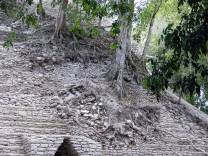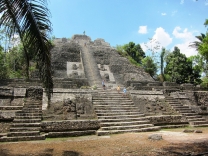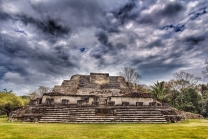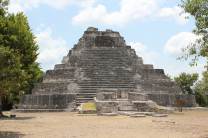
Kohunlich
Kohunlich (X-làabch'e'en in Modern Mayan) is a large archaeological site of the pre-Columbian Maya civilization, located on the Yucatán Peninsula in the state of Quintana Roo about 25 km east of the Rio Bec region, and about 65 km west of Chetumal on Highway 186, and 9 km south of the road. The Spanish name does not actually derive from Mayan but from the English Cohune Ridge where cohune palm grew.
The site covers about 21 acres (85,000 m2), surrounded by dense sub-tropical rainforest, and it contains almost 200 mounds, that remain largely unexcavated. The city was elaborately planned and engineered, with raised platforms and pyramids, citadels, courtyards and plazas surrounded with palace platforms, all laid out to channel drainage into a system of cisterns and an enormous reservoir to collect rainwater.
The site was settled by 200 BC, but most of the structures were built in the Early Classic period from about 250 to 600 AD. Many of them are still covered with thick vegetation and overgrown by trees. The city appears to have functioned as a regional center and stop along the trade routes through the southern Yucatán from Campeche and Rio Bec area to the west, and the cities along the east-coast and to the south, in the el Petén region of Guatemala and neighbouring Belize.
The site is best known for its Temple of the Masks, an Early Classic pyramid whose central stairway is flanked by huge humanized stucco masks. The Temple was built around 500 A.D. and is one of the oldest structures at Kohunlich. After 700 A.D., this temple was covered over with a Terminal...










